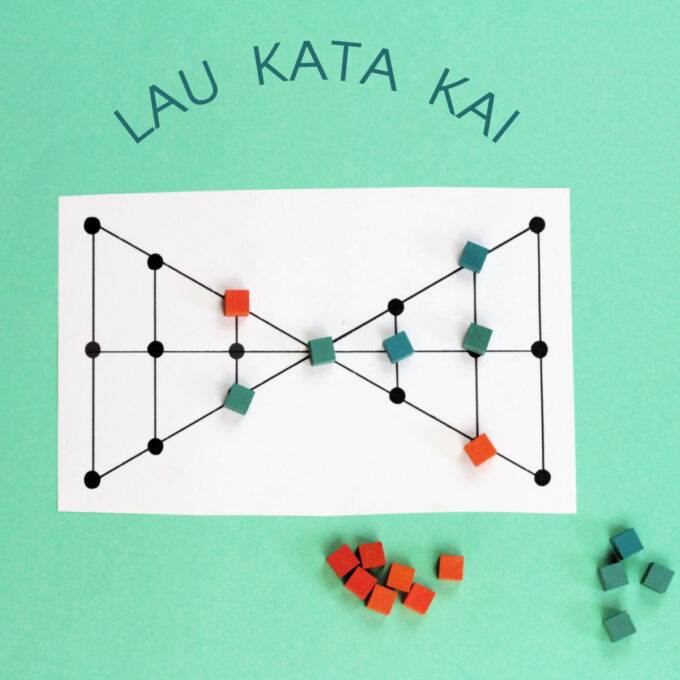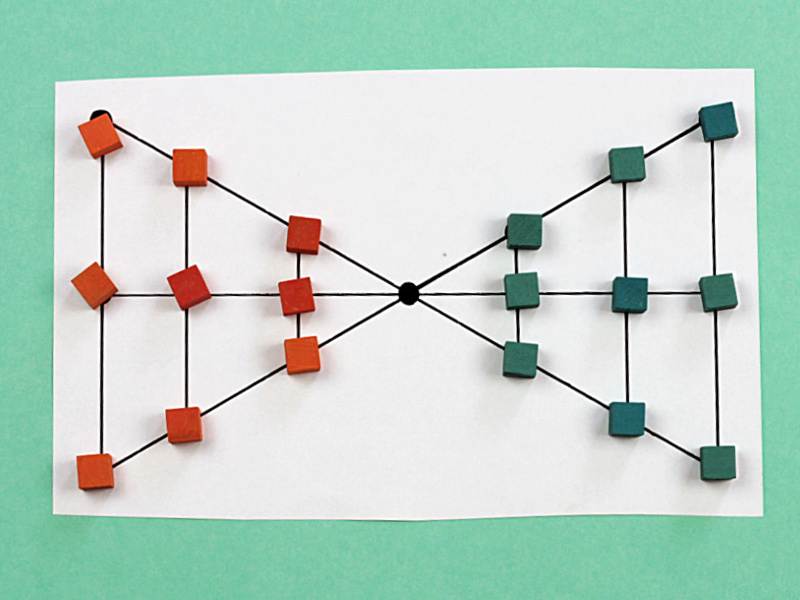Want to get your kids off screens? Entice them with a time-tested traditional game like Lau Kata Kati, an abstract strategy game from India! It's fun, quick to make, easy to learn, encourages logical thinking and rewards perseverance. Could there be a better reason to start playing ASAP?

By the way, don't forget to check out our growing collection of traditional board games from around the world.
About Lau Kata Kati
Lau Kata Kati is part of the Alquerque family of traditional board games. It's a battle-type game in the vein of the familiar game of Checkers. Two opponents face off on a butterfly shaped game board with the objective to capture opposing tokens or block them from moving.
Players will enjoy playing Lau Kata Kati alongside Kaooa, a traditional "hunt game" from India. And, hey, if you're working with students on a unit about India, be sure to read these folktales from India, and these children's books with characters of South-Asian descent!
How to Play
What you need:
- Game board. You can make your own, or use our printable (see form below) The board consists of two triangles connected to each other in a butterfly shape at a common point. Two vertical lines bisect each triangle and a single, horizontal line crosses the length of both triangles, passing through the center vertex. Three "points" lie on each vertical line.
- Nine tokens per player. Use beads, coins, pieces from another game, buttons, etc.

Objective:
Be the first player to capture all your opponent's tokens, or block them from moving.
Now, watch our how-to video, or read the written instructions, below!
Instructions
- Setup
Place tokens on points of play on opposite triangles so that the center point remains empty. (see photo)
Decide who will move first. - Rules of Play
Taking turns, players move one token along a line to an adjacent empty point.
Players capture an opponent's token by jumping over it, along the line, to an adjacent empty point.
If a capture is available, players must take it.
If a player fails to make an available capture, they lose their own token.
Players may capture more than one token in a single turn, as long as it is made with the same token. You may change directions in order to make multiple captures. - Ending the game
The first player to capture all of the opposing tokens, or prevent them from moving, wins.
- Notes
The first move by each player always result in capture.
Near the end of the game when only a few tokens are left, it may appear that the game will end in a draw. If players persevere they may figure out a way to outwit their opponent. However, if the draw continues longer than the players wish, they may decide to end the game, with the player who has the most tokens left on the board as the winner.





Amy Cassidy says
I can not figure out where to find the game board for Lau Kata Kati. I am signed up to receive messages from What Do We Do all Day. The online sections refers to go to the end of the page to find the game board and I am not seeing anythin. Any help is appreciated.
Erica says
Hi Amy,
The form was at the bottom of the post, but I can see how you missed it. I moved it directly under the description of the board in the "what you need" section. You need to enter your email to get it sent to you (it won't subscribe you multiple times, no worries). The form contains the title "Want the printable game board?" in orange font. I hope this helps.
Bilal says
Can a player move in his own part without going forward (repeating a move at the back)